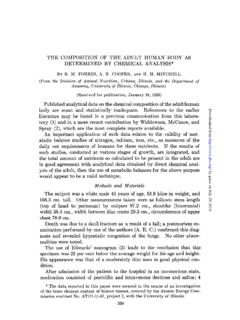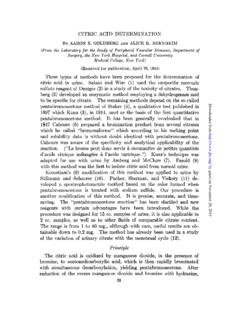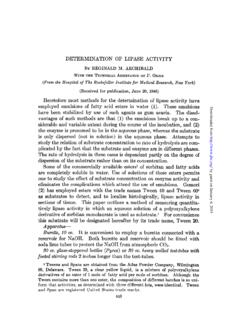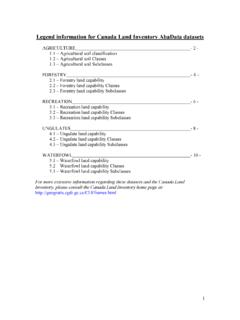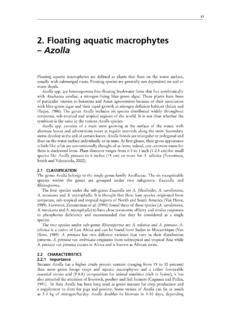Transcription of THE CITRIC ACID FERMENTATION OF ASPERGILLUS NIGER.*
1 THE CITRIC acid FERMENTATION OF ASPERGILLUS NIGER.* BY JAMES N. CURRIE. (From the Research Laboratories, Dairy Division, United States Departmeut of Agriculture, Washington.) PLATES 1 AND 2. (Received for publication, April 20, 1917.) INTRODUCTION. The CITRIC acid FERMENTATION induced by certain fungi has been elaborately studied, especially by His work on this subject and also on the oxalic acid FERMENTATION is familiar to all students of fungi. Wehmer2 believed that the production of CITRIC acid in more than mere traces was characteristic of the group of fungi to which he gave the generic name Citromyces and that the oxalic acid FERMENTATION was characteristic of Asper- gillus niger.
2 This seems to have been accepted by all the other workers who have investigated either the CITRIC or oxalic acid FERMENTATION . Martin,3 in a very recent study of the CITRIC acid FERMENTATION , discarded all cultures of Aspergilli with the assump- tion that their fermentative action was well known and that they did not produce CITRIC acid . It has been noted4 that many cultures of ASPERGILLUS niger produced CITRIC acid . Although the literature on the chemical activity of ASPERGILLUS niger is .voluminous, only one reference has been found relative to CITRIC acid production by this group Published with the permission of the Secretary of Agriculture. 1 Wehmer, C., Beitr. zur Kenntnis einheimscher Pilse, Hannover, 1893, No.
3 1. 2 Wehmer, in Lafar, F., Handb. technischen Mykologie, Jena, 2nd edition, 1905-07, iv, 242. *Martin, J. A., Am. d. Pharm., 1916, lxxxviii, 337. 4 Thorn, C., and Currie, J. N., J. Agric. Research, 1916, vii, 1. 15 by guest on June 16, 2018 from i6 CITRIC acid FERMENTATION of fungi. In 1913 Zahorski5 was granted a patent in the United States on a method for producing CITRIC acid by fermenting sugar solutions with Sterigmatocystis nigra. This is one of the many names that has been used to designate fungi of the black Asper- gillus Zahorski, however, states that Sterigmatocystis differs distinctly from Aspergihs. The writer at first, supposed that Zahorski had worked with some very unusual culture of ASPERGILLUS niger.
4 This impression was probably wrong, for any one of about twenty cultures studied under certain conditions produced CITRIC acid in abundance. In fact almost any culture of ASPERGILLUS niger upon concentrated sugar solutions will produce much more CITRIC acid than oxalic acid . For conducting the CITRIC acid FERMENTATION a well selected culture of ASPERGILLUS wiger is far superior to any culture resembling Wehmer s Citromyces with which the writer has ever worked. In the beginning it was hoped that ASPERGILLUS niger cultures could be divided into two general groups, one of which produced CITRIC acid and the other oxalic acid . This would lend some aid to the problem of classifying this group of black Asper- gilli.
5 In this respect the data are disappointing. No cultures produced CITRIC acid only under all conditions or oxalic acid only under all conditions. Many of the workers who have studied the CITRIC acid fermen- tation performed only a few experiments without being guided by a fundamental knowledge of the metabolism of fungi or of the conditions favorable to the reaction with which they were concerned. Experiments conducted in this way are not likely to make a very definite contribution to any problem. In this paper three fundamental factors with regard to ASPERGILLUS niger have been considered : (1) The inorganic salt, requirements; (2) the general equation of metabolism; and (3) the reaction of the medium.
6 Few concise statements can be made concerning the metab&= of an organism capable of producing such a variety of chemical transformations as ASPERGILLUS niger. What is for one set of conditions may not be true for. another set of conditions differ- ing ever so little. Much of the preliminary work which served no other useful end than to inform the will not be 6 Zahorski, B., U. S. Patent No. 1,066,358, July 1, 1913. by guest on June 16, 2018 from J. N. Currie 17 described in detail, although general conclusions from such pre- liminary work may be related. Results were sometimes obtained which could not be duplicated. Such results have not been included without comment to this effect.
7 Methods Employed. The cultures were selected from those used in the previous study and are designated by the same numbers, with the omission of the first two digits. The chemical reactions must proceed in the mycelium. This floats on the surface of the substrate but wrinkles in such a manner that it presents an enormous surface of contact. These wrinkled structures often project 5 to 6 cm. into the substrate. This pecu- liarity of growth enables the mold to exhaust a deep substrate much more rapidly than if it depended on diffusion alone. Never- theless the ratio of the surface to the volume of the media must be uniform in order to obtain results that have comparative values.
8 A volume of 50 cc. of media contained in a 200 cc. Erlen- meyer flask was used in nearly all of the experiments here reported. The cultures were grown at 28 C. To determine the quantitative relations between the products formed and the sugar consumed, the medium was drained off and the mycelium repeatedly washed. The medium and washings were combined and made up to a definite volume. Separate portions of this solution were then taken for the estimation of oxalic acid , CITRIC acid , and sugar. Oxalic acid was in all cases estimated by double precipitation as calcium oxalate and titration with standard permanganate. The sugar was estimated by reduction with Fehling s solution and calculated from the reducing factor of invert sugar.
9 The CITRIC acid was estimated either by the method of Pratt! or the method of While either method will give fairly satis- factory results if used with discretion and patience, a really con- venient and accurate method for estimating CITRIC acid is still wanting. Carbon dioxide was determined by drawing a gentle current of 6 Pratt, D. S., U. S. Dept. Agrie., Bureau of Chemistry, Circ. 88, 1912. 7 Kunz, R., Arch. them. Mikros., 1914, vii, 285. by guest on June 16, 2018 from 18 CITRIC acid FERMENTATION carbon-dioxide-free air through the flasks containing the grow- ing mold and absorbing the carbon dioxide produced in caustic potash. Diligent search was made for other organic acids, especially malic and tartaric.
10 These were never found and in all probability are never formed at all. The total acidity is nearly exactly ac- counted for by the sum of the oxalic and CITRIC acids regardless of the proportion in which they occur. Both CITRIC and oxalic acids have repeatedly been isolated and identified. The oxalic acid can be recovered directly from the fermented liquors by evaporation and crystallization. CITRIC acid because of its very great solubility has been recovered only through the calcium salt. Several pounds of calcium citrate have been prepared which by analysis corresponds to the formula Caa(CaHs0J24H~0 and in no wise differs from calcium citrate prepared from the citrus fruits.)
